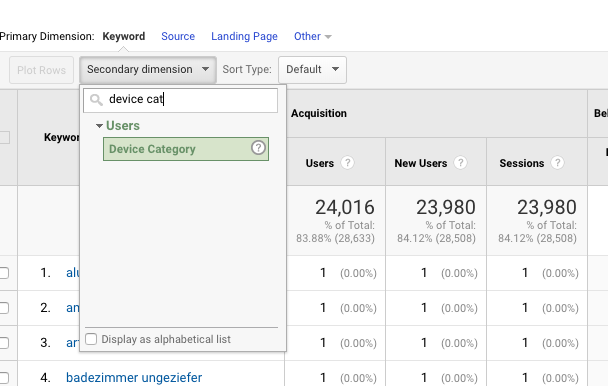Comprehensive Insights Using Secondary Dimension in Google Analytics
Comprehensive Insights Using Secondary Dimension in Google Analytics
Blog Article
Unlock Deeper Insights With Second Dimension in Google Analytics
With the large expanse of data offered in Google Analytics, the utilization of additional measurements can substantially enrich your logical capacities. By strategically integrating additional dimensions into your analysis, you can discover valuable understandings that may otherwise continue to be obscure - Secondary Dimension in Google Analytics.
Understanding Key Vs. Secondary Measurements
When assessing information in Google Analytics, it is vital to differentiate in between additional and key measurements to get deeper understandings right into individual actions. Key measurements are the primary classifications through which you can watch your information, such as source/medium, gadget, or landing page. These dimensions supply the basic structure for organizing and comprehending your data. On the other hand, additional measurements permit you to further dissect your primary dimension data. By adding a second dimension, you can layer on extra details to your primary measurement, enabling an extra granular analysis. As an example, if your main measurement is the source/medium through which customers arrived on your site, including a second dimension like geographic location can disclose where those customers are located geographically. This added layer of info can help you determine patterns, patterns, or anomalies that might not have been obvious when considering the main dimension alone. Consequently, leveraging both additional and key measurements in Google Analytics is important for thorough data evaluation and notified decision-making.
Making Use Of Secondary Dimensions Effectively
By incorporating additional measurements along with key dimensions, experts and marketing professionals can delve much deeper into the specifics of user communications on their internet sites. Second dimensions allow users to segment and filter key measurement data additionally, using a more in-depth sight of user actions, demographics, and interactions.
Moreover, secondary measurements make it possible for users to compare and contrast different data points within a solitary report, helping with a much more comprehensive analysis of customer behavior patterns. By leveraging second dimensions properly, companies can uncover covert understandings, enhance their advertising and marketing approaches, and boost the overall customer experience on their sites.
Checking Out Typical Additional Measurement Mixes
To additionally analyze user actions and trends in Google Analytics, it is useful to explore common combinations of secondary dimensions. Some common additional measurement mixes that supply useful insights consist of examining traffic sources with user locations to comprehend where website visitors are coming from geographically and exactly how they located the website. Analyzing customer behavior metrics with additional measurements such as demographics or interests can help in targeting specific target market sectors more effectively.
Using Secondary Measurement in Custom-made Information
Utilizing secondary measurements in personalized records allows for a more detailed evaluation of information in Google Analytics, improving the deepness of insights obtained. When creating customized records in Google Analytics, incorporating second measurements can provide a more comprehensive sight of just how various dimensions communicate with each various other. This function makes it More Bonuses possible for individuals to dig much deeper into their data and uncover important connections that might not be immediately obvious.
By using additional measurements in customized reports, individuals can get a far better understanding of their website or app web traffic. Integrating the main dimension of "source/medium" with the secondary dimension of "landing web page" can disclose which landing pages are carrying out finest for web traffic coming from details resources. This understanding can help marketers enhance their projects and improve general conversion prices.

Enhancing Data Visualization With Additional Dimension
When exploring information in Google Analytics custom reports, including additional measurements not only gives an extra thorough analysis however additionally enhances the aesthetic depiction of understandings through data visualization. By adding a second measurement to your records, you can improve the way information exists, making it simpler to determine patterns, company website fads, and correlations within your web site's efficiency metrics.
Second dimensions can aid you segment your information additionally, permitting a much deeper understanding of individual behavior and communications on your site. When attempting to separate specific variables that might impact your site's efficiency., this enhanced level of granularity can be specifically helpful.

Verdict
Finally, leveraging secondary measurements in Google Analytics allows for an extra extensive evaluation of information, resulting in much deeper insights and more informed decision-making. Secondary Dimension in Google Analytics. By including extra layers of info to main data collections, analysts and marketing experts can uncover concealed trends, patterns, and correlations that supply a granular view of individual habits and interactions. This improved level of understanding allows optimization of campaigns and customized strategies for specific audience sectors, eventually enhancing performance and conversion prices
On the various other hand, second dimensions permit you to additional study your main measurement data. By adding an additional measurement, you can layer on added details to your key measurement, making it possible for a more granular evaluation. If your primary measurement is the source/medium via which customers arrived on your site, including a secondary important source dimension like geographical area can reveal where those users are located geographically. By including secondary dimensions along with key measurements, marketing experts and analysts can dig much deeper into the specifics of individual interactions on their web sites. Second dimensions enable users to section and filter primary measurement information even more, offering a much more in-depth sight of user demographics, communications, and behaviors.
Report this page